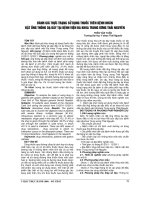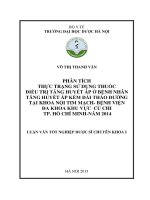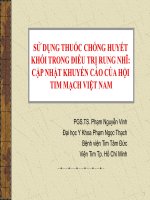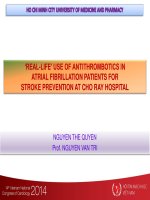Thực trạng sử dụng thuốc chống huyết khối trong dự phòng đột quỵ trên người bệnh rung nhĩ
Bạn đang xem bản rút gọn của tài liệu. Xem và tải ngay bản đầy đủ của tài liệu tại đây (1.58 MB, 22 trang )
‘REAL-LIFE’ USE OF ANTITHROMBOTICS IN
ATRIAL FIBRILLATION PATIENTS FOR
STROKE PREVENTION AT CHO RAY HOSPITAL
NGUYEN THE QUYEN
Prof. NGUYEN VAN TRI
BACKGROUND
Good efficacy of Vitamin K Antagonist (VKA):
• Nonvavular AF: reduce stroke risk over 2.5 times 1
• Valvular AF: embolic events decrease 4 – 15 times 2
However, previous studies of using VKA remains low in Vietnam:
• Nonvavular AF: 7 – 13% use 3
• Valvular AF: 34% 4
This study will re-evaluate the situation.
1.
2.
3.
4.
Camm AJ, et al. Eur Heart J. 2010;31:2369-429.
Bonow RO, et al. J Am Coll Cardiol. 2008;52:e1-142.
Pham Chi Linh, Nguyen Van Si. HCMC University of Medical and Pharmacy. 2011.
Le Hoai Nam. Y Hoc Tp.Ho Chi Minh. 2014;18:209-14.
ESC 2012
ACC 2014
Optional
A score ≥ 3 is considered “high bleeding risk”
ESC recommends “caution” using OACs
STUDY OBJECTIVES
1.
Identify the using rate of antithrombotics in nonvalvular AF patients based on
the stroke risk stratification CHA2DS2-VASc.
2.
Identify the using rate of antithrombotics in nonvalvular AF patients based on
the bleeding risk stratification HAS-BLED.
3.
Identify the using rate of VKA in valvular AF patients based on the bleeding risk
stratification HAS-BLED.
STUDY METHODS
1. Study design
Prospective, cross-sectional study
2. Study population
All patients who were diagnosed AF during admission into Cho Ray hospital
from October 2013 to May 2014
3. Sample size
We use the proportion formular:
𝑍1−𝛼/2
n = p(1 − p)
d
•
2
Nonvalvular AF group:
p = 0,8 based on Pham Chi Linh study → n = 246 (N in our study = 258)
•
Valvular AF group:
p = 0,915 based on our pilot study from October 2013 to November 2013 →
n = 120 (N in our study= 132)
STUDY PROCESS
RESULTS
PATIENT CHARACTERISTIC
Population
Nonvalvular AF
Valvular AF
258
132
69,8 ± 15,9
54,5 ± 14,1
SAMPLE SIZE
Age
Male
132
(51,2)
41
(31,1)
Female
126
(48,8)
91
(68,9)
Heart failure(%)
86
(33,3)
63
(47,7)
History of stroke/TIA (%)
51
(19,8)
33
(25,0)
Diabetes (%)
46
(17,8)
3
(2,3)
History of major bleeding (%)
14
(5,4)
8
(6,1)
158
17
(61,2)
5
(3,8)
Sex catergory (%)
Hypertension (%)
BP ≥ 140/90mmHg
SBP > 160mmHg
History of myocardial infarction (%)
39
(10,8)
(15,1)
Objective 1
Identify the using rate of antithrombotics in nonvalvular AF
patients based on the stroke risk stratification CHA2DS2-VASc.
Stroke risk stratification CHA2DS2-VASc
in nonvalvular AF patients
% nonvalvular AF patients
n = 258
25
20.9
22.1
20
15
13.6
12.8
12
10
8.5
6.2
5
3.1
0.8
0
0
1
2
3
4
5
6
7
CHA2DS2-VASc score
STUDY
CHA2DS2-VASc = 0
CHA2DS2-VASc ≥ 2
GARFIELD
2,9%
84,4%
J-RHYTHM
6,6%
77,9%
Ours
6,2%
81,8%
8
The use of antithrombotics based on CHA2DS2-VASc score
in nonvalvular AF patients
% nonvalvular AF patients
n = 258
100%
14
90%
80%
43.7
70%
41.9
25
50
45.5
24.1
63.6
50
No antithrombotic
Antiplatelet
VKA
14.3
30%
20%
9.1
38.6
9.7
12.5
40%
29.6
57.1
60%
50%
18.2
48.4
43.8
46.3
47.4
36.4
28.6
10%
50
27.3
25
6
7
0%
0
1
2
3
4
5
8
CHA2DS2-VASc score
% patients with
CHA2DS2-VASc =
0 use OAC
% patients with
CHA2DS2-VASc ≥
2 use OAC
EORP-AF
Pilot
56,4%
78,0%
J-RHYTHM
71,1%
89,2%
Ours
43,8%
42,5%
STUDY
n = 211 (Nonvalvular AF patients with CHA2DS2-VASc ≥ 2)
VKA
22.7%
42.5%
Antiplatelet
No antithrombotic
34.8%
The univariate relationship between CHA2DS2-VASc and
antithrombotic use in nonvalvular AF patients
Reference value
Compared value
Use VKA
OR
95% CI
p
1,48
0,78 – 2,82
0,234
3,35
1,44 – 7,82
0,005
CHA2DS2-VASc < 2 CHA2DS2-VASc ≥ 2
Use Antiplatelet
Not follow the current guideline
Objective 2
Identify the using rate of antithrombotics in nonvalvular AF
patients based on the bleeding risk stratification HAS-BLED.
Bleeding risk stratification HAS-BLED
in nonvalvular AF patients
% nonvalvular AF patients
n = 258
45
38.8
40
33.3
35
30
25
20
18.6
15
10
7
2.3
5
0
0
1
2
3
4
HAS-BLED score
STUDY
HAS-BLED = 0
HAS-BLED = 1 - 2
HAS-BLED ≥ 3
AMADEUS
7,8%
68,1%
24,1%
J-RHYTHM
14,3%
70,0%%
15,7%
Ours
18,6%
72,1%
9,3%
The
use of
antithrombotics
based
on HAS-BLED
score
2.1.2. tình
hình
sử
dụng thuốc
chống
huyết khối
in nonvalvular AF patients
% nonvalvular AF patients with
CHA2DS2-VASc ≥ 2
n = 211
100%
90%
80%
37.5
16.7
17.8
26.9
20
70%
60%
37.8
30.8
12.5
No antithrombotic
50
Antiplatelet
60
50%
VKA
40%
30%
20%
50
44.4
42.3
33.3
20
10%
0%
0
1
2
3
4
HAS-BLED score
STUDY
% patients with HASBLED = 0 use OAC
% patients with HASBLED = 1 – 2 use OAC
% patients with HASBLED ≥ 3 use OAC
J-RHYTHM
86,8%
89,7%
86,3%
EORP-AF Pilot
78,9%
78,5% - 84,5%
66,7% - 71,1%
Ours
50,0%
43,5%
30,4%
The univariate relationship between HAS-BLED and
antithrombotic use in nonvalvular AF patients
Reference value
Compared value
Use VKA
HAS-BLED ≤ 2
Use Antiplatelet
Not follow the current guideline
OR
95% CI
p
0,57
0,23 – 1,43
0,232
2,49
1,07 – 5,83
0,035
HAS-BLED > 2
The multivariate relationship between CHA2DS2-VASc, HAS-BLED and
antithrombotic use in nonvalvular AF patients
Our study
Reference value
Compared value
Use OAC
CHA2DS2-VASc < 2
CHA2DS2-VASc ≥ 2
42,5%
HAS-BLED ≤ 2
HAS-BLED > 2
CHA2DS2-VASc < 2
CHA2DS2-VASc ≥ 2
HAS-BLED ≤ 2
HAS-BLED > 2
OR
95% CI
p
1,56 0,82 – 2,99
0,178
0,53
0,21 – 1,34
0,178
3,12 1,33 – 7,32
0,009
2,15
0,081
Use Antiplatelet
Not follow the current guideline
0,91 – 5,06
Objective 3
Identify the using rate of VKA in valvular AF patients based on
the bleeding risk stratification HAS-BLED.
Bleeding risk stratification HAS-BLED
in valvular AF patients
% valvular AF patients
n = 132
50
43.9
45
40
35
30.3
30
25
20.5
20
15
10
4.5
5
0
0
1
HAS-BLED score
2
3
2.2.2.
The use of VKA based on HAS-BLED score
tình hình sử
dụng AF
thuốc
chống huyết
in valvular
patients
n = 132
% valvular AF
patients
n = 132
khối
100%
90%
6.1%
100
93.2
88.9
80%
VKA
70%
No VKA
60%
85.7
50%
93.9%
40%
30%
20%
10%
STUDY
% patients use VKA
RELY – China
42%
Le Hoai Nam
34%
Ours
94%
Each point of
HAS-BLED score rises
0%
0
1
2
3
HAS-BLED score
VKA
Reference value Compared value
VKA
No VKA
No VKA
OR
95% CI
p
2,32
1,03 – 5,24
0,042
CONCLUSION
In nonvalvular AF population, many patients need
to prevent stroke (81,8% CHA2DS2-VASc ≥ 2)
And most of them have little bleeding risk (90,7%
HAS-BLED ≤ 2), however the using rate of VKA
remains low (42,5%).
In valvular AF population, the using rate of VKA
really achieves actual success (94%).









